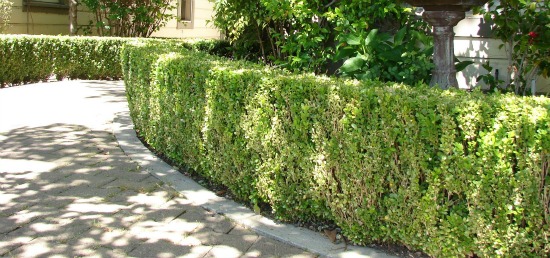Hedge Walls
Hedge walls are an easy way to create garden barriers in or around a yard. Like other landscape walls, they can be created to suit your property’s needs and your personal style. The shrubs that you choose for your natural garden wall may be slow or quick growing. Slow growing shrubs can take years to produce a natural wall, but they will require pruning less often. If you don’t mind frequent maintenance work, quick growing shrubs will give you a substantial hedge sooner. In addition to rate of growth, you need to decide if you want a formal or more informal hedge wall.
Trenched Hedge
The most effective way to create a more formal natural wall is to create a trenched hedge. Here’s a simple series of steps to create this garden feature:
1. Determine the line your hedge will follow by using string and stakes to mark out where you want the wall to sit. If your hedge will curve, use rope to mark the bent line you intend to make.
2. Then, excavate your line so that it is the depth of the plant container and twice the width.
3. Plant your shrubs at a distance that accommodates their space needs when they are fully mature. (Information on the sizes your shrubs will reach at maturity can be found online or at your local nursery.)
4. Set the root balls of your shrubs in the trench and refill the remaining space with amended soil.
5. Very gently compact the amended soil.
6. Add about 5 inches of mulch and then water your news plants.
Staggered Hedge
The most effective way to create an informal hedge wall is to stagger the plants. Here’s a simple series of steps to create this feature:
1. Decide on the shrubs you will use and ask your nursery what their approximate size will be at maturity.
2. Allow a space between the plants equal to about ¾ of their mature size. (Information on your shrubs mature size can be found online or at your local nursery.)
3. Using string and stakes mark out the line where you want the wall to sit.
4. Mark the spots along the string where you will plant your shrubs.
5. Then, excavate your intended planting holes. Generally speaking, you should dig holes that are double the width and equal the height of the root ball. (Again, be sure to check online or ask your local nursery what the particular planting needs are for your chosen shrubs.)
6. On the opposite side of the string mark a staggered row of intended holes.
7. Excavate your planting holes.
8. Set the root balls of your shrubs in and refill the remaining space with amended soil.
9. Very gently compact the amended soil.
10. Add about 5 inches of mulch and then water your new plants.
